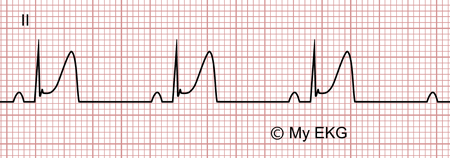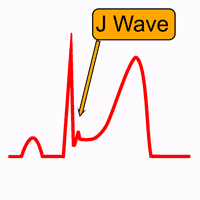Early Repolarization
Early repolarization pattern is a common electrocardiographic finding in healthy populations and is more prevalent in athletes, young individuals and males.
On the electrocardiogram, its main characteristic is an elevation of the QRS-ST junction.
It is generally considered to be benign, but recent studies have demonstrated that it can be linked to a risk of ventricular arrhythmias and sudden cardiac arrest 1 2 3.
Early Repolarization Pattern on the Electrocardiogram
Electrocardiogram of early repolarization pattern is characterized by:
- Elevation of the QRS-ST junction (J point) ≥0.1mV in at least two contiguous leads.
- Terminal QRS slurring or notching (J waves).
- Concave upward ST-segment elevation.
- Prominent T waves 4 5.

Electrocardiogram of early repolarization pattern
J wave, J point elevation and concave upward ST-segment elevation.
Other characteristics of early repolarization pattern:
- Absence of reciprocal changes (except in lead aVR).
- ST changes are relatively stable on serial EKG tracings
J Point Changes in Early Repolarization Pattern
The J point denotes the junction of the QRS complex and the ST-segment on the electrocardiogram.
J point changes are the most important sign of early repolarization pattern, the diagnosis can be made even without ST-segment elevation.
J Wave
The J wave, also known as Osborn wave, is a deflection with a dome or hump morphology in the same direction as the R wave, immediately following the QRS complex 6.
Their presence in left precordial leads or inferior leads is one of the diagnostic criterion for early repolarization pattern.
It is also seen in both extracardiac and cardiac disorders like hypothermia, hypercalcemia, brain injury, hypervagotonia, or spinal cord injury 4.
Terminal QRS Slurring
The other changes of early repolarization pattern is a conduction delay on terminal QRS complex.
It causes QRS-ST junction slurring, without J wave.
In the absence of J wave or terminal QRS slurring, diagnosis of early repolarization pattern is doubtful.
ST-segment elevation is not a required criterion, the diagnosis of early repolarization can be made even without ST-segment elevation 4.
Early Repolarization Considerations
Early repolarization pattern was unanimously regarded as “normal,” a “normal variant”, or a “benign early repolarization” for decades.
However, some studies on survivors of cardiac arrest and patients with primary ventricular fibrillation have suggested an association between early repolarization and the risk of ventricular fibrillation 1-3.
Subtypes of Early Repolarization
Antzelevitch et al.6 propose to divide early repolarization into three subtypes (four subtypes if Brugada syndrome is included):
Type 1: this form is very prevalent among healthy male athletes and is rarely seen in ventricular fibrillation survivors.
Type 2: is associated with a higher level of risk; numerous cases of otherwise idiopathic ventricular fibrillation have this electrocardiographic pattern, which is also prevalent in healthy young males.
Type 3: is associated with the highest level of risk for the development of malignant arrhythmias; has often been associated with ventricular fibrillation storms 6.
However, to date there are no data to support an association between inferior early repolarization and sudden cardiac death in athletes 7.
Treatment of Early Repolarization
Based on current evidence, all patterns of early repolarization on the EKG, when present in isolation and without clinical markers of pathology, should be considered benign variants in athletes and do not require further evaluation 7 8.
Suspension of sports practice is not recommended in athletes 7.
On the contrary, the finding of early repolarization pattern in survivors of sudden cardiac arrest due to idiopathic ventricular fibrillation has indications of implantable cardioverter-defibrillator; but it would have the same indication in the absence of early repolarization.
References
- 1. Haïssaguerre M, Derval N, et al. Sudden cardiac arrest associated with early repolarization. N Engl J Med. 2008;358:2016–2023. doi: 10.1056/NEJMoa071968.
- 2. Nam GB, Kim YH, Antzelevitch C. Augmentation of J waves and electrical storms in patients with early repolarization. N Engl J Med. 2008;358:2078–2079. doi: 10.1056/NEJMc0708182.
- 3. Rosso R, Kogan E, Belhassen B, et al. J-point elevation in survivors of primary ventricular fibrillation and matched control subjects: incidence and clinical significance. J Am Coll Cardiol. 2008;52:1231–1238. doi: 10.1016/j.jacc.2008.07.010.
- 4. Derval N, Sha A, Jaïs P. Definition of Early Repolarization: A Tug of War. Circulation. 2011; 124: 2185-2186. doi: 10.1161/CIRCULATIONAHA.111.064063.
- 5. Macfarlane PW, Antzelevitch C, Haissaguerre M, et al. The Early Repolarization Pattern: A Consensus Paper. J Am Coll Cardiol. 2015;66(4):470-477. doi: 10.1016/j.jacc.2015.05.033.
- 6. Antzelevitch C, Yan GX. J wave syndromes. Heart Rhythm 2010; 7: 549–558. doi: 10.1016/j.hrthm.2009.12.006.
- 7. Sharma S, Drezner JA, Baggish A. International recommendations for electrocardiographic interpretation in athletes. Eur Heart J. 2018. 39(16): 1466–1480. doi: 10.1093/eurheartj/ehw631.
- 8. Ali A, Butt N, Sheikh AS. Early repolarization syndrome: A cause of sudden cardiac death. World J Cardiol. 2015 Aug 26; 7(8): 466–475. doi: 10.4330/wjc.v7.i8.466.
If you Like it... Share it.








